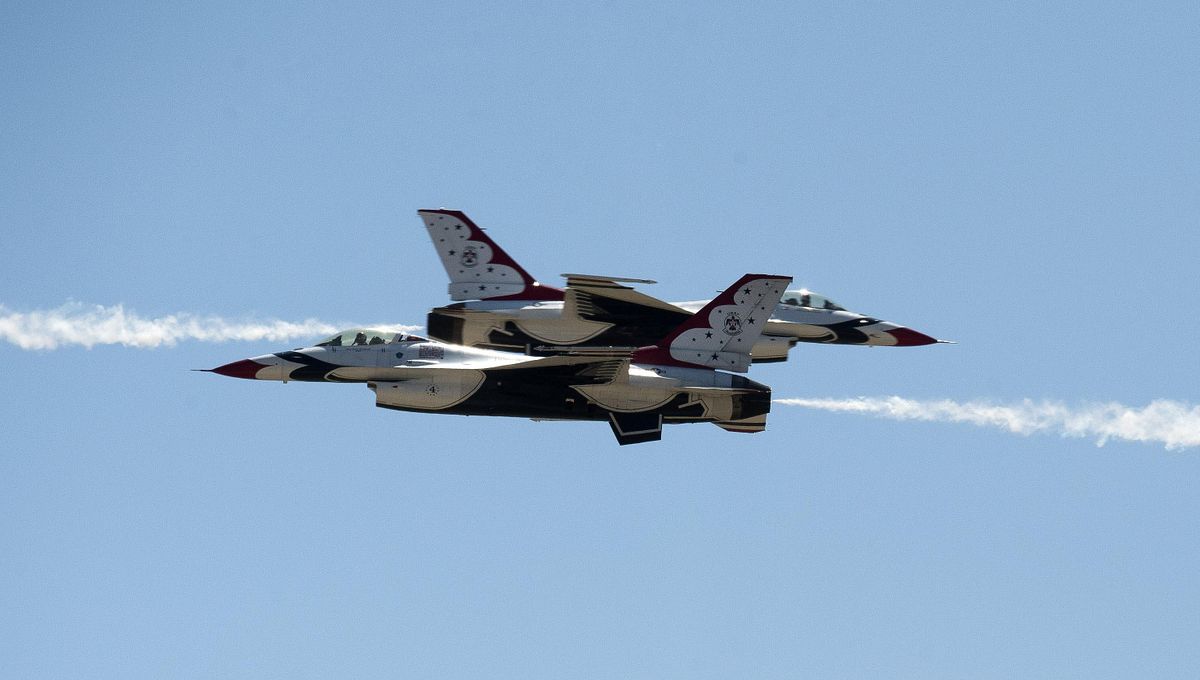Thunderbird pilots roar above Spokane for Skyfest 2017

They come in low and hot from the northwest, four in diamond formation, two peeling off in a roll as they tear open the sky above.
Smoke bellows from the tails of the Thunderbirds, the Air Force’s demonstration squadron. Their engines scream, the sound somehow unattached from the jet it chases just a moment ahead.
The seven F-16s twist and roll, passing each other on knife-edge at unnervingly narrow distances, their wing tips shedding thin white clouds, circling Fairchild Air Force Base over and over again, practicing the maneuvers they’ve done countless times before, but never in this specific place with its particular winds and geography.
The aerial ballet ends, and the pilots bring their supersonic aircraft to the ground, taxiing with an outrageous racket. The forested hills behind them distort in the engines’ hot, spewing exhaust.
Slim and in deep blue jumpsuits emblazoned with a large Thunderbirds patch, the pilots emerge from their cockpits. Garrison caps sit on their heads, and their chests feature the number of their respective jets, 1 through 7. They all seem a little too calm for having just flown near the speed of sound with unimaginable G-forces tugging at their guts.
Maj. Alex Turner, the lead solo pilot, smiles, but his eyes are obscured by Ray-Ban aviators. The 5 on his chest stands on its head.
“Because I fly upside down for most of the show,” explained Turner, who’s been with the Air Force for 12 years. Before joining the Thunderbirds a year and a half ago, he flew 260 combat hours in Libya and Iraq and has logged more than 1,700 hours as an Air Force pilot.
Though just seven of the airmen pilot the fighter jets, the Thunderbirds count 120 Air Force personnel among its ranks, mostly in support positions. This weekend, half of them are at Fairchild for Skyfest 2017, where the demonstration squadron will perform its show for an expected 200,000 people.
Turner never really sought this role, he said, being something of a public affairs officer who flies jets. But he’s come to enjoy it. Before and after the precision demonstrations, he gets to talk with ill children through the Make-A-Wish Foundation. This weekend, he’ll go hang out with the “bubbas” going through survival school on Fairchild and try to cheer them up as they learn the tools of survival, evasion, resistance and escape.
But he assures that he’s no rock star among his fellow airmen.
“I’m going to go take this off and go to dinner and no one will know or care,” he said, referring to his jumpsuit.
Yet soon enough another air show will beckon, and Turner will suit back up and climb into his F-16. He and the plane know each other now, he said. “You develop an amazing amount of muscle memory,” he said of the particular jet’s quirks.
He’ll shoot into the sky, pull back hard and go even higher, up to 50,000 feet. Turner keeps the F-16 well below its capabilities, and will take it to just below Mach 1, not quite the speed of sound. His skin and blood will give to the G-forces, up to 8 Gs or 9 Gs, but he’s been trained not to lose consciousness.
“It’s very tough.” Turner turns to point at the chipping, leading edge of the wing. “You can see me peeling the paint off this jet,” he said, smiling.